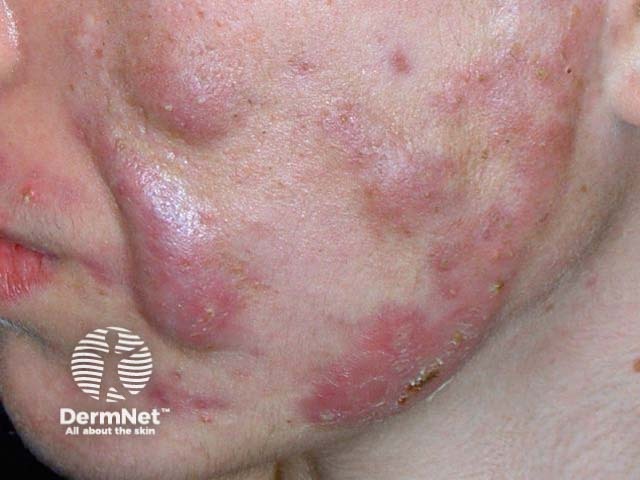Main menu
Common skin conditions

NEWS
Join DermNet PRO
Read more
Quick links
Diagnosing acne is easy. Or is it? Acne has a variety of clinical presentations, and there are a large number of skin conditions that may look similar.
Acne may be confidently diagnosed when there are both typical noninflammatory and inflammatory lesions in the expected distribution in a patient of the right age.
Acne usually affects the face, but it may affect the neck (especially under the jawline), anterior chest, shoulders and upper back. Rarely it extends to upper arms, lower back and buttocks. Rarely it may be segmental (cutaneous mosaicism) or limited to an epidermal naevus (Becker naevus, comedone naevus).
Its onset is often at puberty or during adolescence, but acne may arise in infancy or start for the first time during adult life. It affects males and females equally, but tends to be more severe and extensive in males, and of earlier onset and more prolonged in females.
For each of the sixteen cases, study the image(s) and then answer the questions. You can click on the image to view a larger version if required.
Each case should take approximately 2 minutes to complete. There is a list of suggested further reading material at the end of the quiz.

This teenage boy has bone pain and swollen joints. Name the skin lesion/s.
Acne nodules in SAPHO: Synovitis, Acne, Pustulosis, Hyperostosis, Osteitis
Describe the condition
Very severe acne with systemic features may indicate a syndrome such as SAPHO (Synovitis, Acne, Pustulosis, Hyperostosis, Osteitis).
Other syndromes associated with severe acne include polycystic ovarian syndrome, congenital adrenal hyperplasia, follicular occlusion syndrome and PAPA (Pyogenic Arthritis, Pyoderma gangrenosum and Acne).
Finished!
If you would like to receive a certificate of participation please enter your name below and click Download.